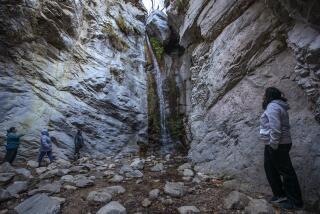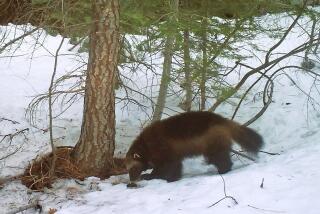Obama proposes expanding oil-drilling ban in Alaska wildlife refuge
President Obama proposed designating 1.4 million acres of the Arctic National Wildlife Refuge as protected wilderness, drawing cheers from environmentalists but setting off a bitter new battle Sunday with the Republican-controlled Congress over oil and gas drilling in pristine areas of northern Alaska.
The plan would permanently bar drilling and other forms of development in the 19.8-million-acre refuge’s coastal plain, a narrow strip between the Brooks Range mountains and the Arctic Ocean where caribou give birth. The area, estimated to hold 10.3 billion barrels of oil, is home to more than 200 species, including polar bears, wolverines, musk oxen and thousands of migratory birds.
“For more than three decades, some voices have clamored to drill for oil in the coastal plain, a move that could irreparably damage this ecological treasure and harm the Alaska Native communities who still depend on the caribou for subsistence,” the White House said in a statement as Obama embarked on a three-day visit to India.
Although the coastal plain has been off-limits to development for years, the White House move marks a new front in the long-running political and environmental battle over whether to authorize oil production in the refuge. It puts the Interior Department on record in favor of keeping it as undeveloped wilderness, despite years of angry demands from Alaska lawmakers to open the area to drilling
Only Congress can designate the area as protected wilderness. But even if lawmakers don’t support the measure, officials said, the Interior Department intends to continue barring oil and gas development — along with road-building and almost every other form of development.
Alaska Republicans condemned the proposal, one of several the Interior Department is likely to announce this month affecting oil and gas drilling in Alaska.
“What’s coming is a stunning attack on our sovereignty and our ability to develop a strong economy that allows us, our children and our grandchildren to thrive,” Sen. Lisa Murkowski (R-Alaska), chairwoman of the Senate Energy and Natural Resources Committee, said in a statement. “But we will not be run over like this. We will fight back with every resource at our disposal.
“These decisions simply cannot be allowed to stand,” she said.
Wilderness designation is the highest form of protection the federal government can give to public lands. No roads, vehicles or permanent structures are allowed. A wilderness designation also prohibits oil and gas drilling, logging and mining.
More than 7 million acres of the 19.8-million-acre refuge are managed as wilderness, but more than 60%, including the coastal plain, does not carry that designation.
Alaska Gov. Bill Walker, an independent, said Obama’s proposal left him “very frustrated.” The refuge is already treated as a wilderness area, he said at a news conference. “Don’t even think about asking” to drill. “We’re down to trying to make a living off a very small piece of ground.”
Rep. Don Young (R-Alaska) called the proposal “a callously planned and politically motivated attack on Alaska by the Obama administration … akin to spitting in our faces and telling us it’s raining outside.”
The White House announcement came months after the defeat of Sen. Mark Begich, an Alaska Democrat who supported drilling in the refuge. So does his replacement, Republican Dan Sullivan.
With Republicans in control of both the House and Senate, lawmakers are unlikely to approve a measure that would permanently bar oil and gas drilling.
But with the global price of oil plunging amid heavy supply, Congress also is unlikely to approve bills introduced every year for decades that would open up the refuge to drilling.
“Is Congress going to pass a wilderness bill? Probably not,” said Cindy Shogan, executive director of the Alaska Wilderness League. But the White House move would help build support in Congress for a permanent wilderness designation and assist in “defensive battles” to block drilling in the refuge, she said.
The battle over whether to open the area to oil and gas drilling has been going on almost since the Arctic National Wildlife Refuge was created in 1960.
The 1.5-million-acre coastal plain -- east of the Prudhoe Bay oil fields -- is called the “1002 area,” a reference to the section of a 1980 law that expanded the refuge and set aside the coastal area for possible oil and gas development, if Congress approved.
In 1987, during the Reagan administration, the Interior Department recommended opening the refuge to drilling. Over the years, the House has at times voted to move forward with drilling. Such proposals have always been blocked in the Senate, where the refuge has many defenders.
The Interior Department made the recommendation to designate the coastal plain as wilderness as part of a revision to the Fish and Wildlife Service’s conservation plan for the Arctic refuge.
“Designating vast areas in the Arctic National Wildlife Refuge as wilderness reflects the significance this landscape holds for America and its wildlife,” Interior Secretary Sally Jewell said in a statement. “Just like Yosemite or the Grand Canyon, the Arctic National Wildlife Refuge is one of our nation’s crown jewels and we have an obligation to preserve this spectacular place for generations to come.”
Native Alaskans, who hunt caribou and other wildlife in the coastal plain, applauded the White House proposal.
“This is great news,” said Sarah James of the Gwich’in Steering Committee, a group that seeks protection of native lands. “Oil development there would hurt the caribou and threaten the Gwich’in way of life.” The Gwich’in include many tribes of Native Alaskans who live mostly above the Arctic Circle.
The Fish and Wildlife Service is also recommending that four rivers – the Atigun, Hulahula, Kongakut and Marsh Fork Canning – be protected as National Wild and Scenic Rivers.
The 20- to 40-mile-wide coastal plain is where 130,000 Porcupine caribou give birth to calves after an annual trek from Canada, one of the last great mammal migrations in the world.
Although caribou range over a large area, they prefer the coastal plain for calving because its openness gives predators nowhere to hide, thus protecting the calves. It also provides plenty of nutritious grasses for forage and relief from insects.
Wildlife experts note that production drilling requires permanent facilities -- pipelines, drill pads and roads. During calving season, caribou tend to avoid such development, and there’s little room for them on the narrow plain.
“A wilderness designation will finally protect the ‘biological heart’ of the Arctic National Wildlife Refuge, where caribou have their young after completing a 1,500-mile migration -- the longest of any mammal on Earth,” said David J. Hayes, a former deputy Interior secretary who is now at the Center for American Progress, a Washington think tank. “Other oil fields are available. The Arctic refuge is too special a place to drill.”
Staff writer Lisa Mascaro contributed to this report.
More to Read
Start your day right
Sign up for Essential California for news, features and recommendations from the L.A. Times and beyond in your inbox six days a week.
You may occasionally receive promotional content from the Los Angeles Times.







